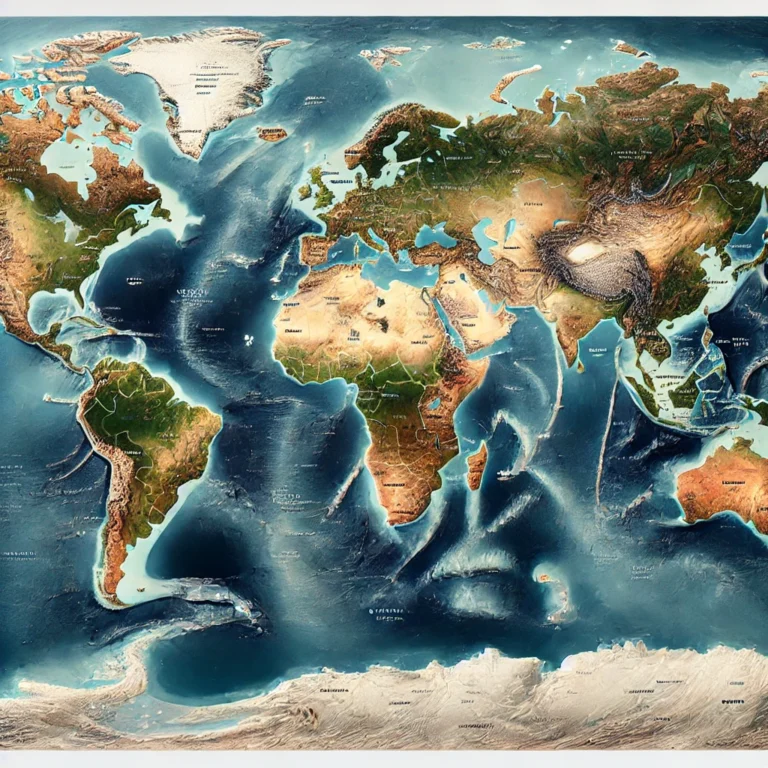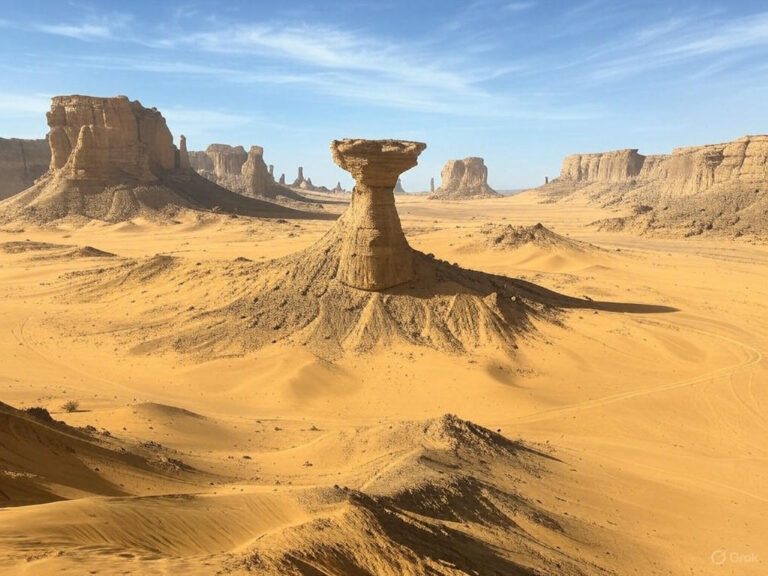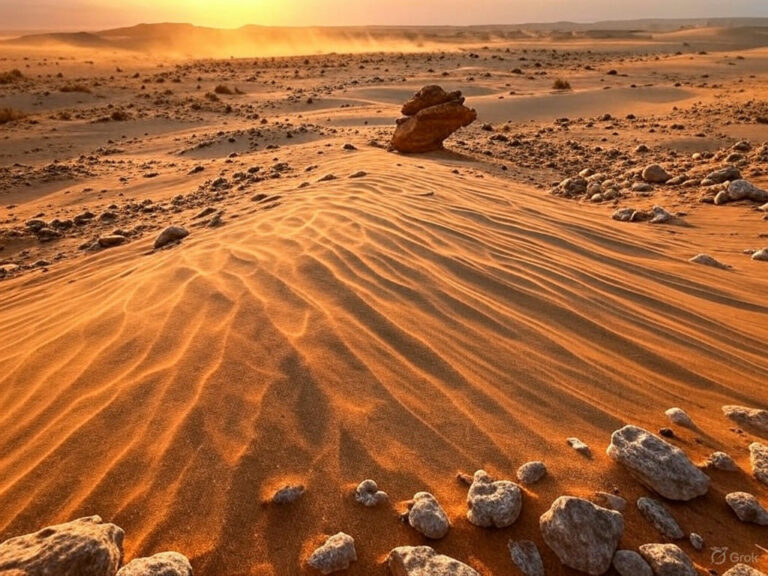Hotspot Volcanism
When we think of volcanoes, we often imagine fiery eruptions along plate boundaries — where plates collide or drift apart. But what if a volcano appears right in the middle of a plate, far from any plate boundary?
This anomaly puzzled geologists for decades… until they discovered something deeper — Hotspots and Mantle Plumes.
🔥 What is Hotspot Volcanism?
🔍 Basic Definition
Hotspot volcanism refers to volcanic activity that occurs away from plate boundaries, usually in the interior of lithospheric plates. It is caused not by plate tectonics but by abnormally hot regions deep inside the Earth’s mantle, called mantle plumes.
🔑 Key idea: Unlike most volcanoes that occur at tectonic plate margins, hotspot volcanoes erupt from fixed ‘heat spots’ under the moving plates.
🚫 Exceptions: Not Always in the Middle
While most hotspots are located inside tectonic plates (like Hawaii), some exist right on divergent boundaries, such as:
- Iceland Hotspot (on the Mid-Atlantic Ridge)
- Afar Hotspot (at the Afar Triple Junction in East Africa)
🌡️ Mantle Plumes: The Engine Behind the Hotspots
A mantle plume is like a jet of abnormally hot rock that rises from the core-mantle boundary through the mantle.
🧠 Structure of a Mantle Plume:
- Shaped like a mushroom
- Bulbous head: flattens and spreads as it nears the lithosphere
- Thin tail: acts as a long conduit for hot material
🔍 Key Features:
- Originate deep in the mantle, possibly near the core
- Appear fixed in location (unlike convection cells that shift)
- Can uplift land, fracture crust, and cause massive eruptions
Following is a diagram showing a cross section though the Earth’s lithosphere (in yellow) with magma rising from the mantle (in red). The crust may move relative to the plume, creating a track.

🌋 Mantle Plumes and Flood Basalt Volcanism
Also called Large Igneous Provinces (LIPs)
When the plume head reaches the base of the lithosphere, it spreads laterally and causes:
- Decompression melting
- Formation of huge volumes of basaltic magma
- Fissure eruptions over wide areas → Flood Basalts
🌍 Examples of LIPs:
- Deccan Traps (India)
- Siberian Traps (Russia)
- Ontong Java Plateau (Pacific Ocean)
- Columbia River Basalts (USA)

☠️ Flood Basalt Events and Extinction Events
Some mass extinctions in Earth’s history coincide with major mantle plume eruptions:
| Event | Year | Effect |
| Siberian Traps | ~250 mya | Linked to Permian–Triassic extinction (Earth’s largest extinction) |
| Deccan Traps | ~66 mya | Coincides with Cretaceous–Paleogene extinction (dinosaurs wiped out) |
Note: The Deccan event occurred alongside the Chicxulub meteor impact — both likely contributed to mass extinction.
🌋 Hotspot Volcano Chains
A tectonic plate moves over a fixed hotspot.
- As the plate shifts, the old volcano moves away from the hotspot and becomes extinct.
- A new volcano forms over the hotspot.
- This creates a chain of volcanoes, progressively older along the direction of plate movement.
📍 Best Example:
Hawaiian Islands
- Oldest: near Aleutian Trench
- Youngest: Big Island (Mauna Loa, Mauna Kea) — still active
Such age progression is proof of plate motion over a fixed hotspot.
Refer to the following diagram showing a cross section through Earth at the Hawaii hotspot. Magma originating in the mantle rises into the asthenosphere and lithosphere. A chain of volcanoes is created as the lithosphere moves over the source of magma. (“Ma” means millions of years old/ago).

Here is a simple diagram that you can draw to illustrate in mains answer writing for the formation of chain of volcanoes.

🔁 Examples of Hotspot Trails
| Volcanic Trail: A time progressive path of volcanic features formed as a plate moves over a stationary hotspot. Emphasizes age progression. |
| Hotspot | Volcanic Trail |
| Réunion | Chagos–Laccadive Ridge, Mascarene Islands |
| Yellowstone | Snake River Plain |
| Louisville | Louisville Ridge |
| Iceland / Galapagos | No age-progressive trail (located on plate boundaries) |
🌍 Case Study: Réunion Hotspot
- Originated under present-day Reunion Island
- Created the Deccan Traps (~66 mya)
- As India drifted north, it left behind:
- Chagos-Laccadive Ridge (Lakshadweep is part of this)
- Maldives, Chagos Archipelago
- Hotspot later passed under Africa and formed:
- Mauritius
- Reunion
- Rodrigues

🧭 Mantle Plumes and Plate Tectonics
Plumes can rupture and split tectonic plates from below. When a plume rises:
- It exerts extensional stress on the plate above
- Causes stretching, cracking, and rifting
🌍 Example: Afar Hotspot
- Located at Afar Triple Junction
- Splits Arabian, Somalian, and Nubian plates
- Active rifting has begun — Africa is literally tearing apart
🏔️ Uplifted Landforms and Epeirogeny
As the plume head reaches the base of the crust:
- It spreads laterally and uplifts the surface into broad domes
- These are epeirogenic movements
📍 Example:
- Ethiopian Highlands — uplifted due to mantle plume
- Later split by Great Rift Valley, forming a unique domed-rift structure
🪨 Mantle Plumes and Crustal Thinning
In continental settings (e.g. Yellowstone), the rising plume exerts tensional force on the crust:
- Leads to crustal thinning
- Prepares ground for future supervolcanic eruptions
💣 Supervolcanoes and Mantle Plumes
When a massive amount of magma accumulates, but fails to escape due to strong overlying crust:
- Pressure builds up over thousands of years
- When it breaks — the result is a super-eruption
🚨 Criteria:
- Magma > 1000 km³
- Volcanic Explosivity Index (VEI) = 8
Examples:
| Super volcano | Location | Notes |
| Yellowstone Caldera | USA | Under continental crust |
| Toba Caldera | Indonesia | Caused global winter 74,000 years ago |
| Taupo | New Zealand | Oruanui eruption (26,000 years ago) — largest in 70,000 years |
⚠️ Disaster Potential
Supervolcanoes can:
- Cause regional extinction
- Disrupt global climate
- Release sulphur aerosols, leading to volcanic winters
- Blanket continents with ash, collapse ecosystems and agriculture
🧩 Final Takeaway
Hotspot volcanism is anomalous because it defies the typical rulebook of plate tectonics. But it also provides critical evidence of deep Earth processes that shape continents, change climates, and trigger mass extinctions.
In UPSC Mains, you can use it to link:
- Volcanism + Plate Tectonics
- Mass Extinction Events
- Epeirogeny + LIPs + Supervolcanoes
- Energy resources (Geothermal)
- Tourism + Biodiversity Hotspots




